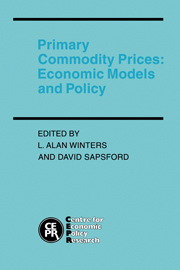Book contents
- Frontmatter
- Contents
- List of figures
- List of tables
- Preface
- List of conference participants
- 1 Primary commodity prices: an introduction to the major policy and modelling challenges
- I ECONOMETRIC ANALYSES
- II SECTORAL STUDIES: FOODS, MATERIALS AND ENERGY
- 5 Modelling the interactive effects of alternative sets of policies on agricultural prices
- 6 Price determination in the market for aluminium
- 7 Long-run factors in oil price formation
- III STABILIZATION SCHEMES
- Index
6 - Price determination in the market for aluminium
from II - SECTORAL STUDIES: FOODS, MATERIALS AND ENERGY
Published online by Cambridge University Press: 05 March 2012
- Frontmatter
- Contents
- List of figures
- List of tables
- Preface
- List of conference participants
- 1 Primary commodity prices: an introduction to the major policy and modelling challenges
- I ECONOMETRIC ANALYSES
- II SECTORAL STUDIES: FOODS, MATERIALS AND ENERGY
- 5 Modelling the interactive effects of alternative sets of policies on agricultural prices
- 6 Price determination in the market for aluminium
- 7 Long-run factors in oil price formation
- III STABILIZATION SCHEMES
- Index
Summary
Introduction
Consultants and industrial economists think about the world in a quite different way from academics.
First, they have more information. Much of the data available to consultants comes from proprietary studies, which may not be available to academics. And if data is available, academics are often surprisingly unaware of it. For a good recent example of this, see Fama and French (1988).
Second, consultants are less sophisticated in matters of modelling technique. In part, this is because we are simple fellows. But in addition, consultants are severely constrained by the need to present their models and results to clients, who will often be non-economists. Clients distrust forecasts, and will be very quick to reject any findings which are based on a model which they do not understand. It is essential that models are simple and transparent, and that the clients can see the little wheels going round.
Thus consultants use models that have simple logic but which are knowledge-intensive. This paper describes a forecasting approach of this type, as applied to the aluminium industry; although the detailed specification of a model will not be pursued here. The paper naturally reflects the special features of the aluminium industry; but models using similar methods are in common use by consultants and industrial economists concerned with other metal commodities.
Such models generally work by asking in what way the world would be different if only expectations were formed in a rational and consistent manner, instead of the way that they are.
- Type
- Chapter
- Information
- Primary Commodity PricesEconomic Models and Policy, pp. 134 - 156Publisher: Cambridge University PressPrint publication year: 1990
- 3
- Cited by



